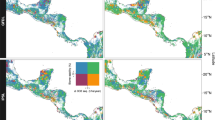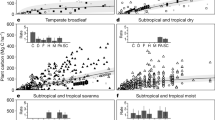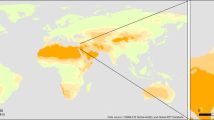Abstract
Climate change can be thought of in terms of geographical shifts in climate properties. Examples include assessments of shifts in habitat distributions1, of the movement needed to maintain constant temperature or precipitation2, and of the emergence and disappearance of climate zones3. Here I track the movement of analogue climates within climate models. From the model simulations, I define a set of vectors that link a historical reference climate for each location to the location in a changed climate whose seasonal temperature and precipitation cycles best match the reference climate. I use these vectors to calculate the change in vegetation carbon storage with climate change due to ecosystems following climate analogues. Comparing the derived carbon content change to direct carbon projections by coupled carbon–climate models reveals two regions of divergence. In the tropical forests, vector projections are fundamentally uncertain because of a lack of close climatic analogues. In the southern boreal forest, carbon losses are projected in the vector perspective because low-carbon ecosystems shift polewards. However, the majority of carbon–climate models—typically without explicit simulation of the disturbance and mortality processes behind such shifts—instead project vegetation carbon gains throughout the boreal region. Southern boreal carbon loss as a result of ecosystem shift is likely to offset carbon gains from northern boreal forest expansion.
This is a preview of subscription content, access via your institution
Access options
Subscribe to this journal
Receive 12 print issues and online access
$259.00 per year
only $21.58 per issue
Buy this article
- Purchase on Springer Link
- Instant access to full article PDF
Prices may be subject to local taxes which are calculated during checkout


Similar content being viewed by others
References
Davis, M. B. & Shaw, R. G. Range shifts and adaptive responses to quaternary climate change. Science 292, 673–679 (2001).
Loarie, S. R. et al. The velocity of climate change. Nature 462, 1052–1055 (2009).
Williams, J. W., Jackson, S. T. & Kutzbach, J. E. Projected distributions of novel and disappearing climates by 2100 AD. Proc. Natl Acad. Sci. USA 104, 5738–5742 (2007).
Dobrowski, S. Z. et al. The climate velocity of the contiguous United States during the 20th century. Glob. Change Biol. 19, 241–251 (2012).
Ackerly, D. D. et al. The geography of climate change: Implications for conservation biogeography. Divers. Distrib. 16, 476–487 (2010).
Veloz, S. et al. Identifying climatic analogs for Wisconsin under 21st-century climate-change scenarios. Climatic Change 112, 1037–1058 (2012).
Friedlingstein, P. et al. Climate–carbon cycle feedback analysis: Results from the C4MIP model intercomparison. J. Clim. 19, 3337–3353 (2006).
Booth, B. B. B. et al. High sensitivity of future global warming to land carbon cycle processes. Environ. Res. Lett. 7, 024002 (2012).
Fung, I., Doney, S., Lindsay, K. & John, J. Evolution of carbon sinks in a changing climate. Proc. Natl Acad. Sci. USA 102, 11201–11206 (2005).
Koven, C. D. et al. Permafrost carbon-climate feedbacks accelerate global warming. Proc. Natl Acad. Sci. USA 108, 14769–14774 (2011).
Jones, C., Lowe, J., Liddicoat, S. & Betts, R. Committed terrestrial ecosystem changes due to climate change. Nature Geosci. 2, 484–487 (2009).
Smith, T. M. & Shugart, H. H. The transient response of terrestrial carbon storage to a perturbed climate. Nature 361, 523–526 (1993).
Shevliakova, E. et al. Carbon cycling under 300 years of land use change: Importance of the secondary vegetation sink. Glob. Biogeochem. Cycles 23, GB2022 (2009).
Sykes, M. T. & Prentice, I. C. Boreal forest futures: Modelling the controls on tree species range limits and transient responses to climate change. Wat. Air Soil Pollut. 82, 415–428 (1995).
Scheffer, M., Hirota, M., Holmgren, M., Van Nes, E. H. & Chapin, F. S. Thresholds for boreal biome transitions. Proc. Natl Acad. Sci. USA 109, 21384–21389 (2012).
Anderegg, W. R. L., Kane, J. M. & Anderegg, L. D. L. Consequences of widespread tree mortality triggered by drought and temperature stress. Nature Clim. Change 3, 30–36 (2013).
Kurz, W. A. et al. Mountain pine beetle and forest carbon feedback to climate change. Nature 452, 987–990 (2008).
Macias Fauria, M. & Johnson, E. A. Large-scale climatic patterns and area affected by mountain pine beetle in British Columbia, Canada. J. Geophys. Res. 114, G01012 (2009).
Bentz, B. J. et al. Climate change and bark beetles of the Western United States and Canada: Direct and indirect effects. BioScience 60, 602–613 (2010).
Hayes, D. J. et al. Is the northern high-latitude land-based CO2 sink weakening? Glob. Biogeochem. Cycles 25, GB3018 (2011).
Taylor, K. E., Stouffer, R. J. & Meehl, G. A. An overview of CMIP5 and the experiment design. Bull. Am. Meteorol. Soc. 93, 485–498 (2012).
Ji, J., Huang, M. & Li, K. Prediction of carbon exchanges between China terrestrial ecosystem and atmosphere in 21st century. Sci. China 51, 885–898 (2008).
Arora, V. K. et al. Carbon emission limits required to satisfy future representative concentration pathways of greenhouse gases. Geophys. Res. Lett. 38, L05805 (2011).
Dunne, J. P. et al. GFDL’s ESM2 global coupled climate-carbon Earth System Models Part I: Physical formulation and baseline simulation characteristics. J. Clim. 25, 6646–6665 (2012).
Cox, P. M. in Description of the TRIFFID Dynamic Global Vegetation Model (Hadley Center Technical Note, Vol. 24, UK Met Office, 2001).
Jones, C. D. et al. The HadGEM2-ES implementation of CMIP5 centennial simulations. Geosci. Model Dev. 4, 543–570 (2011).
Krinner, G. et al. A dynamic global vegetation model for studies of the coupled atmosphere-biosphere system. Glob. Biogeochem. Cycles 19, GB1015 (2005).
Acknowledgements
This research was supported by the Director, Office of Science, Office of Biological and Environmental Research of the US Department of Energy under Contract No. DE-AC02-05CH11231 as part of their Climate and Earth System Modelling Program. We acknowledge the World Climate Research Programme’s Working Group on Coupled Modelling, which is responsible for CMIP, and we thank the climate modelling groups (listed in Tables 1 and 2 of this paper) for producing and making available their model output. Thanks to W. Collins, M. Torn, J. Chambers, W. Riley, P. Friedlingstein and I. Fung for helpful discussions, and to D. Ackerly and C. Jones for a critical review that improved the manuscript.
Author information
Authors and Affiliations
Corresponding author
Ethics declarations
Competing interests
The author declares no competing financial interests.
Supplementary information
Supplementary Information
Supplementary Information (PDF 25806 kb)
Rights and permissions
About this article
Cite this article
Koven, C. Boreal carbon loss due to poleward shift in low-carbon ecosystems. Nature Geosci 6, 452–456 (2013). https://doi.org/10.1038/ngeo1801
Received:
Accepted:
Published:
Issue Date:
DOI: https://doi.org/10.1038/ngeo1801
This article is cited by
-
Approaching a thermal tipping point in the Eurasian boreal forest at its southern margin
Communications Earth & Environment (2023)
-
Northern expansion is not compensating for southern declines in North American boreal forests
Nature Communications (2023)
-
Northern Hemisphere drought risk in a warming climate
npj Climate and Atmospheric Science (2021)
-
Quantifying microbial control of soil organic matter dynamics at macrosystem scales
Biogeochemistry (2021)
-
Fine-grained climate velocities reveal vulnerability of protected areas to climate change
Scientific Reports (2020)



